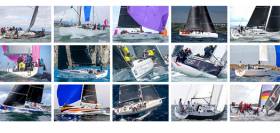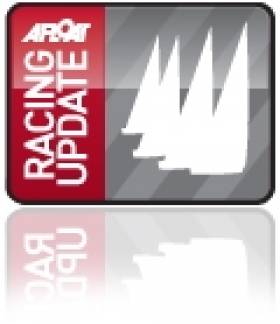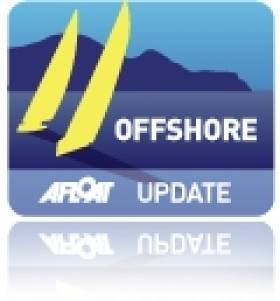Displaying items by tag: X Yacht
Top Yachts 2020: Olympic Sailor Picks 15 Race Boats from 30-50 Feet
Olympian and Sailing Coach Mark Mansfield runs through the options available for an owner looking to buy a new boat for racing in the 30 to 50-foot range and picks his top 15 from the market
Having sailed in numerous regattas over the last few years, there are clear designs that feature well on the IRC rating system used in Ireland, the UK, France and many other European countries. Some of the 15 that I have selected below are more offshore orientated, some are true cruiser-racers, with nice interiors, and only one is a full-on racing boat.
There are, of course, numerous other designs that are no longer in production, or one-off boats. However, these 15 are yachts that could be purchased now, and in most cases be sailing and racing in Irish waters by the middle of the summer next year.
I have selected the 30 to 50-foot range as that is where the majority of new boats purchased now come from. So here goes, in size order, largest first. The pricing mentioned are the basic prices without Instruments, sails or safety gear.
1: X Yachts Xp 50
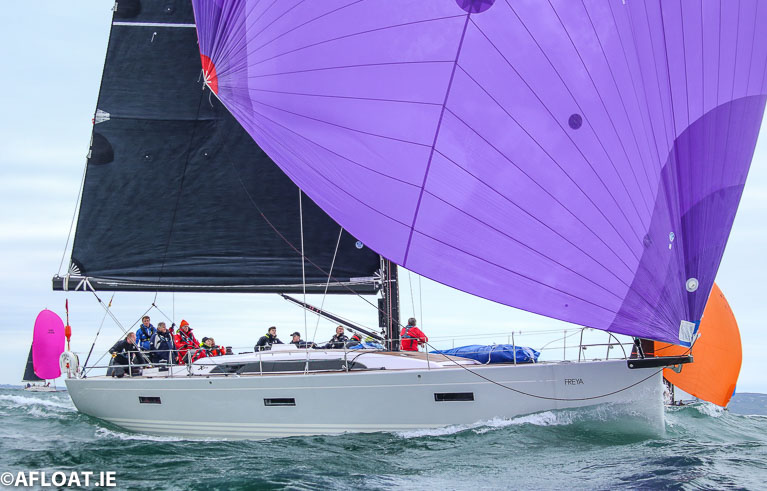 XP50 - a proper cruiser-racer with a luxurious interior Photo: Afloat
XP50 - a proper cruiser-racer with a luxurious interior Photo: Afloat
One of these is already gracefully sailing and racing in Ireland—Freya, owned by Conor Doyle of Kinsale. She has had some flashes of speed so far. Internationally there are a number of them doing well on IRC. A proper cruiser-racer with a very luxurious interior. Takes a bit of handling those large sails though.
Pricing—From €636,000 plus VAT. Available mid-July 2020
2: Grand Soleil 48
 Grand Soleil 48 Performance
Grand Soleil 48 Performance
A new design in 2018. A model designed for both Comfort but also speed. Nearly all Grand Soleil designs perform very well on Irc. The Grand Soleil 43 was an exceptional design, and it is suspected that the 48 will follow along these lines. Very well built yachts, but also with lovely interiors.
Pricing from €459,000 plus VAT. Available mid-July 2020
3: X Yachts Xp 44
 XP44 - Sovereign's Cup class winner WOW (above) Photo: Bob Bateman
XP44 - Sovereign's Cup class winner WOW (above) Photo: Bob Bateman
The X Yachts XP 44 has been around for a few years, but in those years, it has acquitted itself very well on the race courses around Europe on IRC. In Dublin, George Sisk's new Wow is an XP 44 and they have already won their class at Sovereign's week. A true dual-purpose yacht with a lovely interior.
Pricing from €358,000 plus VAT. Available mid-July 2020
4: J122e
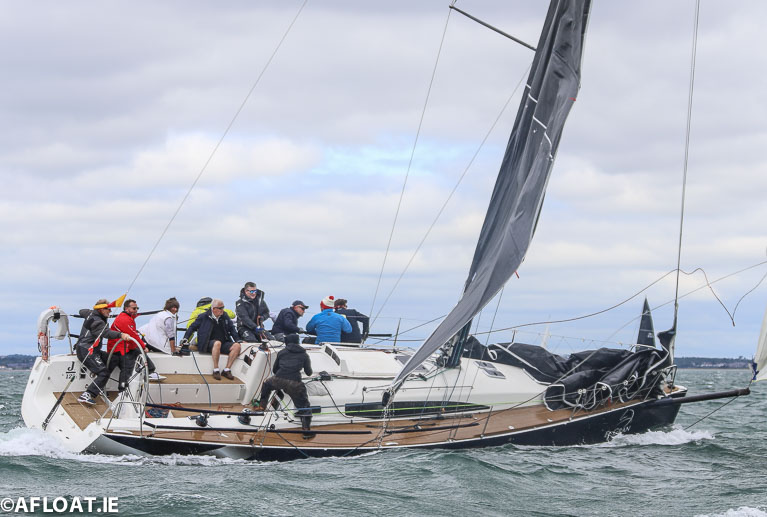 J122e - Clyde based El Gran Senor (above) combines comfort and speed Photo: Afloat
J122e - Clyde based El Gran Senor (above) combines comfort and speed Photo: Afloat
The J122e is a development of the very successful J122 design. Technically the e-versions from J Yachts are supposed to relate to cruising comforts, but all three designs with this 'e' designation appear to be extremely competitive and very good on IRC. Jonathan Anderson from the Clyde has been very successful with His J122e—El Gran Senor. A very good 40-footer combining comfort with speed.
Pricing from €296,000 plus VAT. Available Spring 2020
5: Italia Yachts 11.98
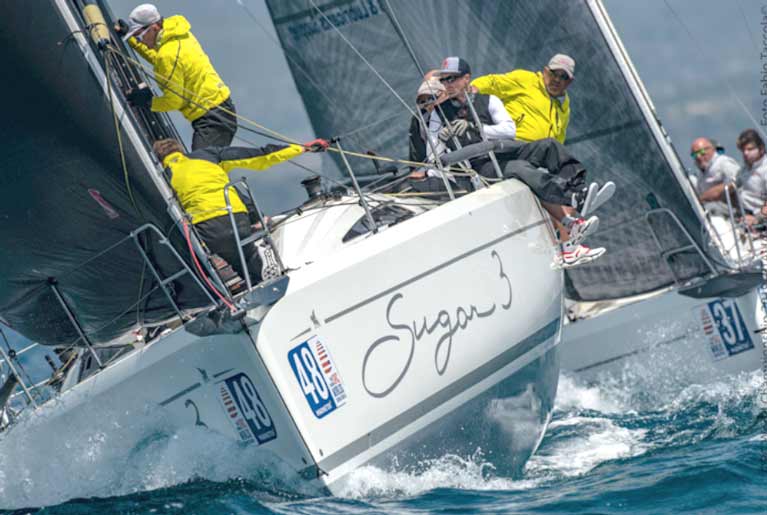 Italia Yachts 11.98 - launched in 2019
Italia Yachts 11.98 - launched in 2019
The brand New Italia Yachts 11.98 was only launched early this season but already has finished very well in some ORC and IRC regattas in the Mediterranean. The smaller sister, Italia Yachts 9.98 finished a close second at the 2018 IRC worlds. These boats would be very able performers on IRC and still have a decent interior.
Pricing from €210,000 plus VAT. Available Spring 2020
6: JPK 11.80
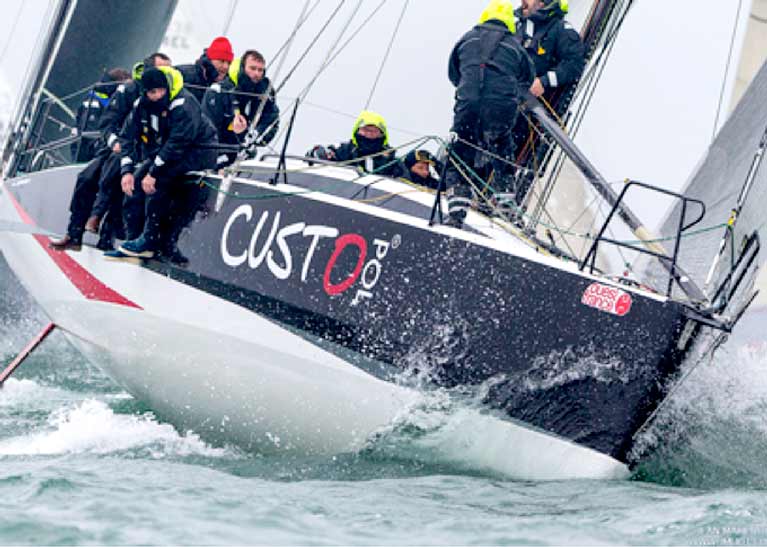 JPK 11.80 - Cowes Week class winner
JPK 11.80 - Cowes Week class winner
The JPK 11.80 is the big sister of the all-conquering JPK 10.80. Built to the same high standards, they are primarily a racing boat but actually have very good levels of comfort below deck. One of these has already won its class over the last two years at Cowes Week
Pricing from €209,000 plus VAT. Available June 2020
7: Melges IC37
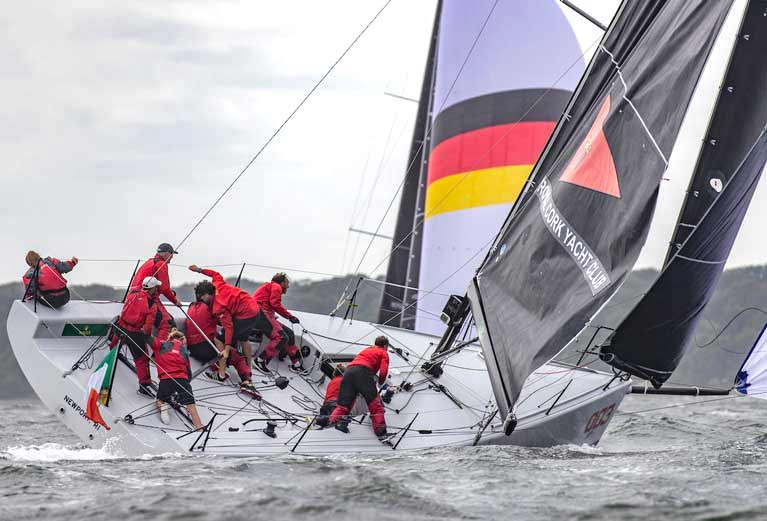 IC37 - The latest one design for New York Yacht Club where Royal Cork (above) sailed to podium success in September Photo: Daniel Forster
IC37 - The latest one design for New York Yacht Club where Royal Cork (above) sailed to podium success in September Photo: Daniel Forster
Designed by County Wicklow yacht designer Mark Mills. This design has become the latest one-design for the New York Yacht Club. Not big on creature comforts, it has however shown itself to be a potent IRC performer and while only recently launched, won its class in Cowes Week this year with a string of firsts.
Pricing from €265,000 plus VAT. Available Spring 2020
8: J112e
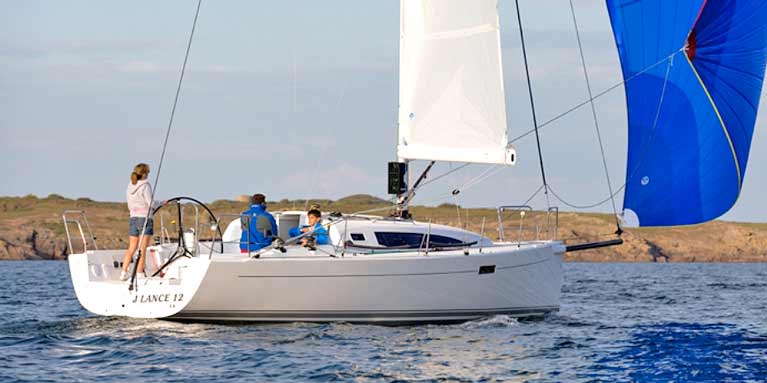 J112e - IRC Worlds and IRC Europeans winner
J112e - IRC Worlds and IRC Europeans winner
The J112e has become one of the most successful IRC boats ever. In 2018, one of these won both the IRC Worlds and IRC Europeans. Built-in France, these designs offer a true compromise between racing and cruising. In Ireland, there are already three of these racing and I would expect more.
Pricing from €199,000 plus VAT. Available Dec 2019
9: JPK 10.80
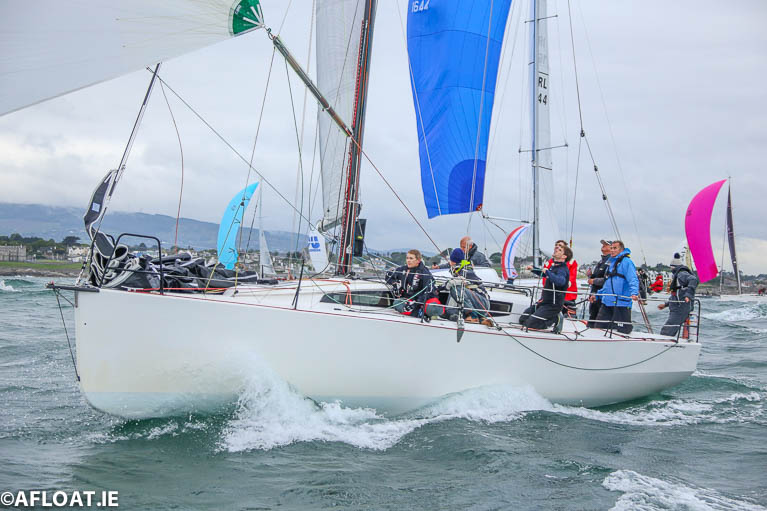 JPK 10.80 - Paul O'Higgins' Rockabill VI (above) has won the last two Dun Laoghaire to Dingle races Photo: Afloat
JPK 10.80 - Paul O'Higgins' Rockabill VI (above) has won the last two Dun Laoghaire to Dingle races Photo: Afloat
The JPK 10.80 is well known in Irish waters, as Paul O'Higgins Rockabill VI has won the last two Dun Laoghaire to Dingle races, and has also been crowned ISORA Champion for 2019. This design has won the Fastnet Race overall and, though a few years old, it is still winning on the world stage. Pretty well-appointed down below, it excels in a breeze, particularly downwind.
Pricing from €142,000 plus VAT. Available Spring 2020
10: Grand Soleil 34
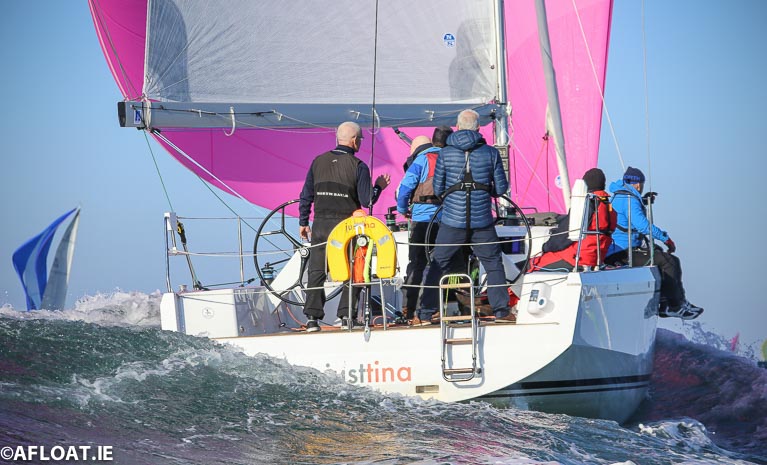 Grand Soleil 34 - Justtina (above) sails on Dublin Bay Photo: Afloat
Grand Soleil 34 - Justtina (above) sails on Dublin Bay Photo: Afloat
All Grand Soleil yachts are built very well, and the 34 is no exception. There is one in Dublin, Justina, and it is clear even from looking at her on the dock that she is a class act. She has shown flashes of brilliance since arriving and clearly there is more potential to be had. Very nicely fitted out down below.
Pricing from €149,000 plus VAT Available Spring 2020
11: J99
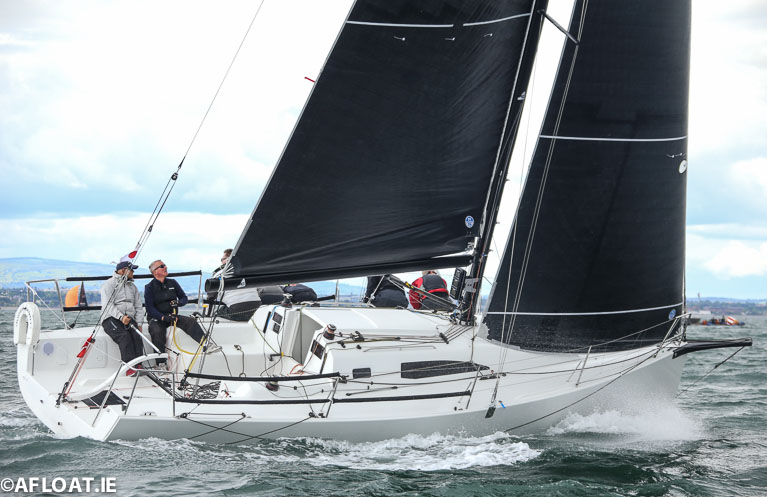 J99 - excels off the wind Juggerknot 2 (above sailing on Dublin Bay in her 2019 debut season Photo: Afloat
J99 - excels off the wind Juggerknot 2 (above sailing on Dublin Bay in her 2019 debut season Photo: Afloat
The J99 is the new kid on the J Yachts portfolio. Designed to be able to be crewed by fewer people, there is one in Dublin already, Juggerknot 2 skippered by Andrew Algeo. The jury is out on whether it is going to be as successful as the j109, but there is still more speed to be found in this design. She excels off the wind where her lighter displacement and planing hull show off her abilities. Very well built, like all J boats and very much a premium, high-class product.
Pricing from €114, 000 plus VAT. Available Feb 2020
12: JPK 10.30
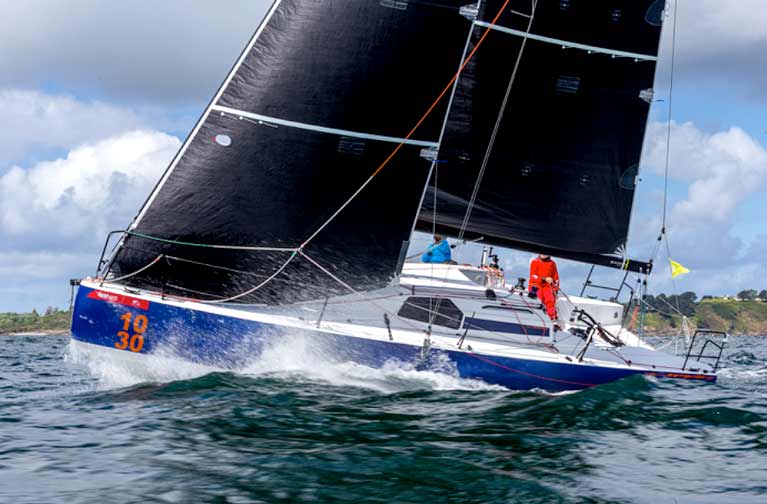 JPK 10.30 - Fastnet class winner
JPK 10.30 - Fastnet class winner
The JPK is a new design from early 2019. It has won its class of 85 entries in the 2019 Fastnet race. It replaces the JPK 10.10. Very much in the mould of all the Other JPK boats, they perform very well offshore and were designed to be crewed shorthanded. However, that is not to say that they cannot be crewed inshore with a full crew. Interior would be simple, but very usable for racing. Expect to see a few of these in the next few years in Ireland.
Pricing from €114,000 Plus VAT. Available Spring 2020
13: Jeanneau Sunfast 3300
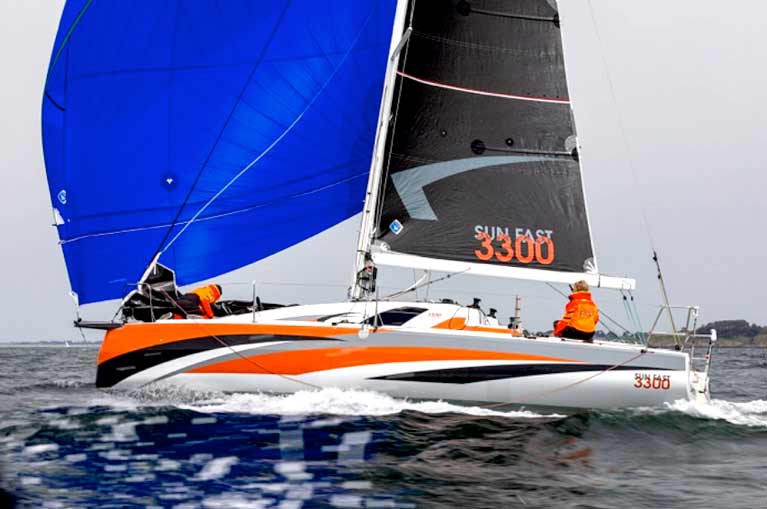 Jeanneau Sunfast 3300 - water ballast removes the need for a large crew
Jeanneau Sunfast 3300 - water ballast removes the need for a large crew
The Jeanneau Sunfast 3300 is very much along the lines of the JPK 10.30. Similar in size and rating, the two designs have been having a great Battle this year. The Sunfast bested the JPK in the opening event, Spi Ouest, whereas the JPK won her class(with the Sunfast 3300 second) in the Fastnet. Both boats are relatively light allowing them to plane easily and so are very suited for downwind sailing. Rumour is that there is an order being finalised on a Sunfast 3300 as we speak, and it will be sailed very competitively by an experienced owner. The Sunfast 3300 allows water ballast, thus removing the need for a very large crew.
Pricing from €104,000 plus VAT. Available March 2020
14: Italia 9.98
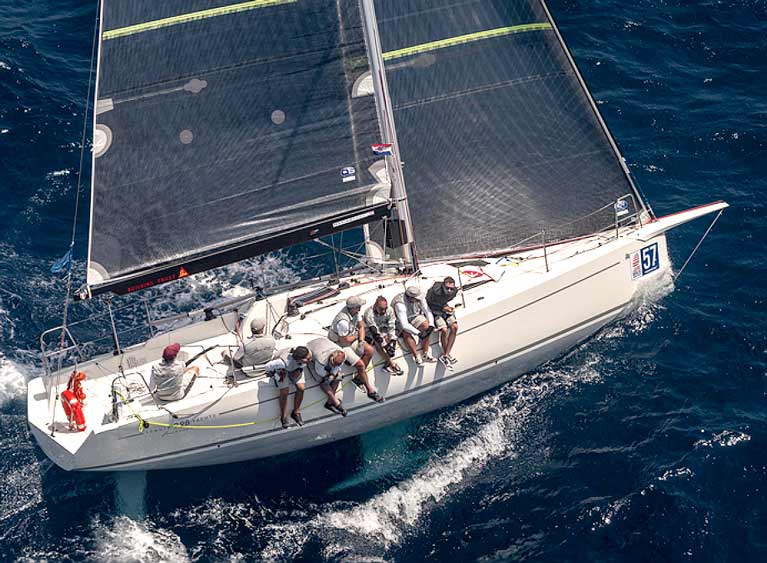 Italia 9.98 - second in class at the 2018 IRC Worlds
Italia 9.98 - second in class at the 2018 IRC Worlds
Italian Built, and a wonderful pedigree. None in Ireland yet, and I don’t know why. This design came second in her class in the 2018 IRC Worlds, and was quite close to the excellently well-sailed J112e, j lance. Since then the Italia 9.98 has added a new IRC orientated Keel to make her even a better IRC boat. Very potent all-round boat and well built.
Pricing from €119,000 plus VAT. Available Spring 2020
15: J97E
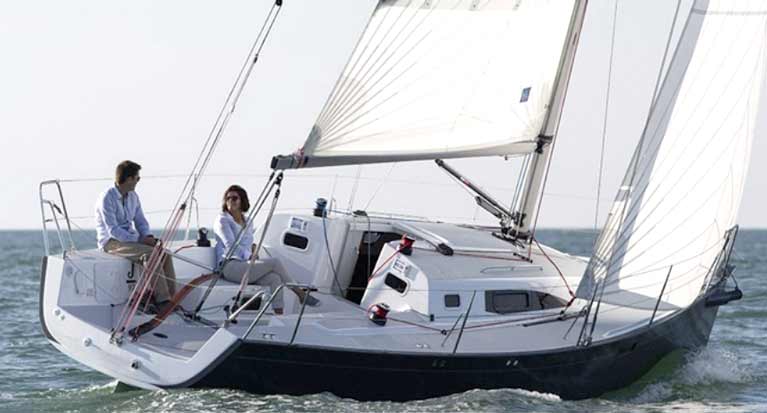 J97E - features well under IRC
J97E - features well under IRC
Like her larger sisters, the J97e comes from a fine pedigree of boats designed to be potent race boats but also having a well fitted out interior. So far none have arrived into Ireland yet but there are a few of the older J97 models around and they feature well under IRC.
Pricing from €130,000 plus VAT. Available December 2019
So, that is the 15 yachts I have chosen. Should any prospective owner want further details or would like to discuss why I like these models, feel free to contact me below
Useful Irish race boat sales links
Free Berthing for First 30 Entries in X Yachts Cup
Competitors will benefit from the following:
* Free Berthing for the first 30 confirmed entries
* Event T-Shirts for all competitors
* Breakfast for all competitors on race days
* Buffet and X-Yacht Bitter at the B & G Crew Party on Friday 6 May
* Hot Snacks and X-Yacht Bitter after racing each day
This year the event will be sponsored by North Sails, Harken, SailTek, CrewFuel, B & G, Pantaenius and Robinsons Brewery.
Irish Sailors Tell of 'Vicious' Conditions in the Med
Both Irish skippers who retired from the Rolex Middle Sea Race that finishes today at the Royal Malta Yacht Club have described the 'vicious' conditions encountered in the Mediterranean this week. The fleet suffered several knowdowns and at least one man overboard but the bulk of the fleet were safely secured in either Marsamxett Harbour this morning with just two racing. 15 had retired.
Last night Dun Laoghaire's Cathal Drohan, sailing his third Middle Sea Race on the X41 Legally Brunette, spoke of 40 knots squalls and visibility near shipping lanes being reduced to five or six boat lengths.
"The boat was well founded and we had a great crew but after five days racing we were looking at a further long stretch of sailing and a severe forecast". Drohan told Afloat.ie from Malta.
All skippers in the race were mindful of the safety of crews given one sailor had been seriously hurt in a knockdown in a heavy squall.
The Royal Malta Yacht Club has calculated the winners and these are set out below.
Barry Hurley sailing on the Maltese yacht Aziza sent the following back to Afloat.ie after the yacht retired:
"We were sailing in sustained low 30knts all day Tuesday and encountered several vicious squalls, often adding up to 20 knots to the average windspeed. Such squalls are common in the area and always play a significant part in the Middle Sea Race. By Wednesday morning the seas had grown substantially and rounding Pantelleria we received an updated weather forecast for sustained mid 40's on Wednesday afternoon. We believe we were lying 4th overall at that stage so were keen to press on, but faced with the prospect of potential 60's in the squalls we made the decision to retire into Pantelleria in the interest of safety. A few hours later an Italian X Yacht came in alongside needing medivac for a crew member seriously hurt in a knockdown in just such a squall, so our decision was vindicated. A somewhat disappointing end to another fantastic Middle Sea Race, but for now it's back home to Dublin until the Sydney Hobart race in December".
Press Release from organisers:
ROLEX MIDDLE SEA RACE CLASS WINNERS CONFIRMEDOctober 28, 2010
If the early miles of the Rolex Middle Sea Race were a test of patience, the latter miles were a true test of endurance. A strong mistral of up to 40+ knots helped push the fleet homeward to the finish in Malta. The last two yachts, Zizanie and Amethyst Abroad, were around the island of Lampedusa and racing towards the finish line off the Royal Malta Yacht Club. The two boats showed heaps of perseverance for hanging in, even if the northwesterly breeze had subsided to a 'mere' 25+ knots.
Meanwhile the bulk of the fleet were safely secured in either Marsamxett Harbour or around the corner in Grand Harbour Marina, and the overall class standings were sorted as the last boats trickled in.
IRC Overall – Lucky (USA)
IRC 1 – Esimit Europa 2 (SLO)
IRC 2 – Lucky (USA)
IRC 3 – Jaru (MLT)
IRC 4 – Artie (MLT)
ORC Overall – Jaru (MLT)
ORC 1 – E1 (RUS)
ORC 2 – Varuna (GER)
ORC 3 – Jaru (MLT)
ORC 4 – Three Sisters (CZK)
Double Handed – BOV Plain Sailing (MLT)
Racing offshore double handed is not for the faint-hearted. It requires all-round seamanship, determination, stamina and above all courage. At the 606-nautical mile Rolex Middle Sea Race, the Double Handed Class is somewhat under the radar with only three entrants, but this year's competitors were a diverse and experienced group.
Taking line honours in the Double Handed Class was White Star, a custom 54-footer, which finished yesterday afternoon with an elapsed time of 4 days, 6 hours, 44 minutes, and 18 seconds. But the Italian boat would have to wait until today when BOV Plain Sailing finished, to see who would win on corrected time.
White Star's crew were experienced double handed sailors Diego Tisci and Daniele Chiamenti; Tisci is a veteran of eight Rolex Middle Sea Races, Chiamenti several as well, but this is the first double handed Middle Sea for either of them. An Italian owner built the yacht and is entering it in double handed races as a way to showcase its' potential. As Tisci said, "This was the first race of a new program for the boat. It was like a test; so we see how the yacht goes, how we have to optimize that and the crew.
"We had a problem at the start and we broke the jib, this is why we stayed far to the east on the way to Messina. We could only use the staysail and code zero, which doesn't allow you to sail very close to the wind – that's why we had a very strange track! At the end that was the best we could do. Around Stromboli, we didn't have much wind and again it was difficult to go to weather without the proper headsail.
Chiamenti explained, "After that the race was very strategic. But our strategy was based on the sails that we had, not on the wind!" When the forecast coincided with this strategy, White Star was in good shape. From Trapani on, the northwest breeze allowed them a favourable point of sail. To add to their woes, White Star lost instruments as well. The two sailors estimated maximum wind speed at approximately 35 knots; but off the wind, and with a staysail set, they were good to go.
Asked about the best part of sailing double handed, Tisci said with a smile "I think the team.
But really, I like sailing short-handed. It's nice to be at sea. You don't have to argue about what you think is right or wrong; it's your race, just yours. You aren't a wheel in a big mechanism; you are only the mechanism. And we take all decisions together."
The two concurred about the course, and Chiamenti said, "For sure it's the best race in the Mediterranean. It's very tactical, and the panorama is great. You've got a volcano, you've got the Messina Strait, and the time of year is great, it's not too cold, not too warm.
The 34-footer, BOV Plain Sailing, crossed the line midday on Thursday after five days, zero hours and 52 minutes at sea. Their corrected time was good enough to give the Maltese boat the Double Handed Class overall win.
Maltese sailing veteran, skipper/owner Anthony Camilleri is no stranger to the Rolex Middle Sea Race, sailing in his tenth race. But his crew, Gilbert Azzopardi has never raced two-handed before and neither has the boat. The Tango 34 is the smallest and lightest boat of the 76 yachts that started the race.
Camilleri spoke dockside after completing the race, "I am delighted that we have won, but first and foremost, I must give a mention to Bepe Bisotto, skipper of Atame. We had a great battle, often side-by-side, but when we developed a problem with the reefing lines of our mainsail, he offered to stop and help. That offer of assistance shows the spirit of our discipline, we look after each other.
"Probably the lowest moment in the race was the last night. We were tired and the weather was really bad, up to forty knots of wind on the beam, with six metre waves crashing into the cockpit. We took down the mainsail and continued under storm jib alone, it was the hardest part of the race. This race is one of contrasts and the previous day the sailing was spectacular. Downwind with the spinnaker up, we were surfing at a constant 12 knots, at times accelerating to 18 knots. It is an amazing feeling with just the two of us, a very special moment."
Last night, the Fast 42 Atame pulled into Trapani to get a respite from the relentless wind and sea. Beppe Bisotto emailed, " 'Ad impossibilia' (it's impossible), as the Latins say. Ian (Knight) and I shared the same thinking. Outside, a Force 8 gale is blowing hard from the north. No way to pass Favignana island, as we had been stopped for ten hours with no wind. We missed the wind shift, blowing at SW Force 7 straight into the face, with forecast predicting force 8 on the back. More than this, to Pantelleria Force 7 SW on the nose was forecast. So, surrounded by gales, we decided to stop and avoid any possible damage. Do not forget that we were only two- handed instead of a full crew of eight to ten. By the way, we are happy to have raced faster than many bigger boats with full crew! Atame is definitely solid, fast, and reliable."
Only the x40 Pita Maha (ITA), retired today, bringing the total number of retired boats to 15, with 58 boats finished, and two still racing.



























